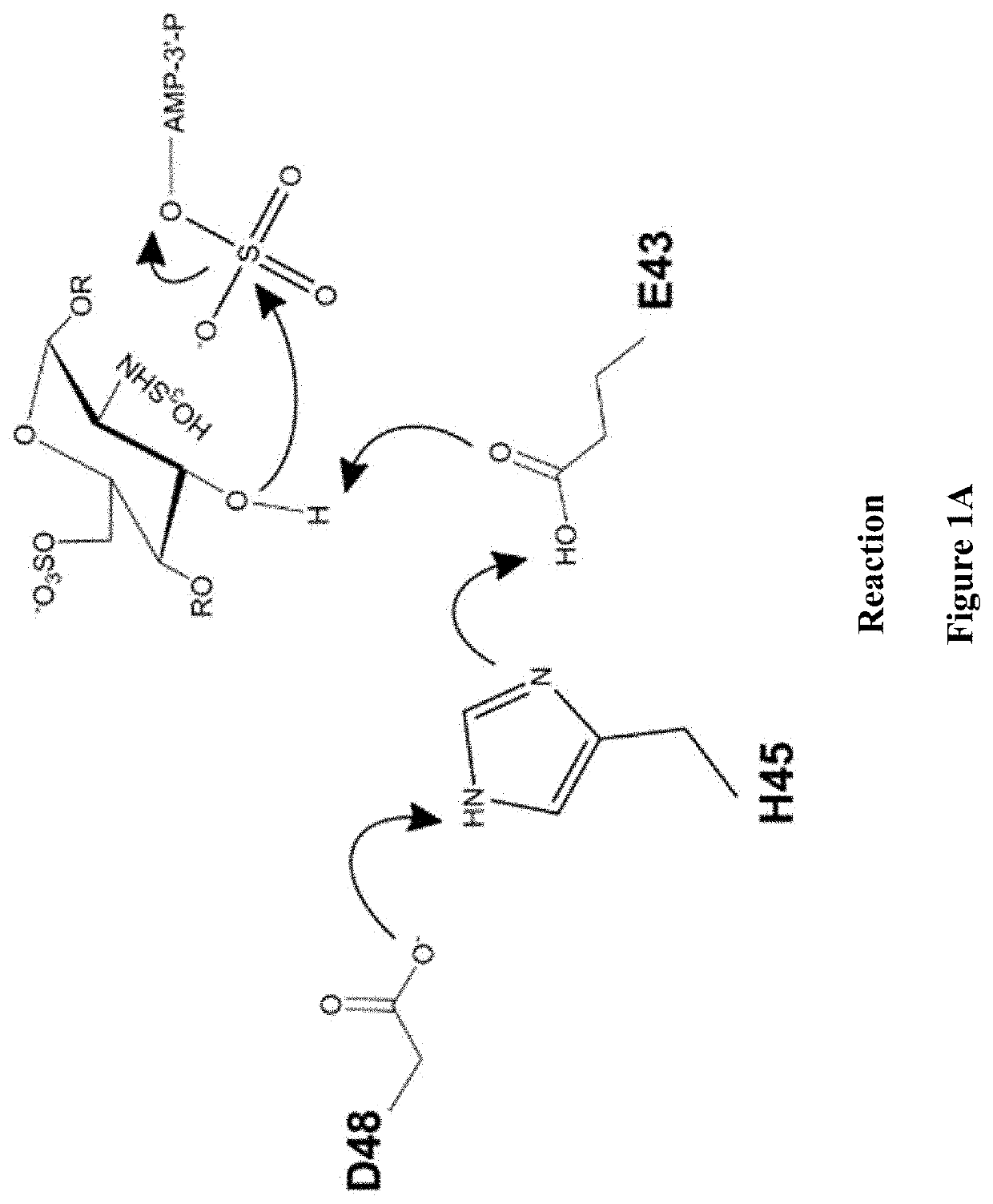Methods for synthesizing anticoagulant polysaccharides
a polysaccharide and anticoagulant technology, applied in the direction of transferases, rasemaces/epimerases, extracellular fluid disorders, etc., can solve the problem that the same short half-life renders paps unsuitable for most in vitro syntheses, and achieve the effect of preventing blood clotting
- Summary
- Abstract
- Description
- Claims
- Application Information
AI Technical Summary
Benefits of technology
Problems solved by technology
Method used
Image
Examples
example 1
Expression, and Purification of the Engineered Aryl Sulfate-Dependent Sulfotransferases
[0424]A study was conducted in accordance with embodiments of the present disclosure to determine whether genes according to the present invention could be transformed into host cells capable of overexpressing engineered aryl sulfate-dependent sulfotransferases. After expression, each aryl sulfate-dependent enzyme was isolated and purified from the host cell.
[0425]Generally, DNA coding for genes of any sequence can be synthesized de novo by methods commonly known in the art, including but not limited to oligonucleotide synthesis and annealing. Alternatively, DNA can be synthesized commercially and purchased from any one of several laboratories that regularly synthesize genes of a given sequence, including but not limited to ThermoFisher Scientific, GenScript, DNA 2.0, or OriGene. Persons skilled in the art would appreciate that there are several companies that provide the same services, and that t...
example 2
trometric Characterization of the N-Sulfated Polysaccharide Products of Engineered Aryl Sulfate-Dependent NST Enzymes
[0433]A study was conducted in accordance with embodiments of the present disclosure to confirm NST activity of enzymes comprising the amino acid sequence of SEQ ID NO: 2, SEQ ID NO: 4, SEQ ID NO: 6, SEQ ID NO: 8, SEQ ID NO: 10, or SEQ ID NO: 12 by detecting the presence of N-sulfated polysaccharide products formed as a result of their sulfotransfer reaction, using mass spectrometry (MS). Each engineered enzyme was purified according to the procedure of Example 1. Sulfotransferase activity was monitored in 100 μL reactions containing 50 μM of enzyme. To each purified protein solution, 20 mg of an aryl sulfate compound (either PNS or NCS) was dissolved in 2 mL of reaction buffer (50 mM MES pH 7.0, 2 mM CaCl2)), added to the protein solution, and incubated at 37° C. for 10 min. 2.5 mL of 2 mg / mL solution of N-deacetylated heparosan was added to protein / donor solution an...
example 3
trometric Characterization of the 2-O Sulfated Polysaccharide Products of Engineered Aryl Sulfate-Dependent 2OST Enzymes
[0438]A study was conducted in accordance with embodiments of the present disclosure to confirm 2OST activity of enzymes comprising the amino acid sequence of SEQ ID NO: 14 or SEQ ID NO: 16 by detecting the presence of 2-O sulfated polysaccharide products formed as a result of their sulfotransfer reaction, using a similar procedure as in Example 2, except that the sulfo acceptor polysaccharide was commercial heparin in which the 2-O sulfate groups had been selectively removed by chemical means (product DSH001 / 2, available from Galen Laboratory Supplies) and analysis of each of the digested samples containing sulfated products was conducted using mass spectrometry, coupled with SAX-based high performance liquid chromatography (LCMS).
[0439]Disaccharides obtained by digesting the 2-O sulfated products using the carbon-oxygen lyases having the amino acid sequence of SE...
PUM
| Property | Measurement | Unit |
|---|---|---|
| Mw | aaaaa | aaaaa |
| Mw | aaaaa | aaaaa |
| molecular weight | aaaaa | aaaaa |
Abstract
Description
Claims
Application Information
 Login to View More
Login to View More - R&D
- Intellectual Property
- Life Sciences
- Materials
- Tech Scout
- Unparalleled Data Quality
- Higher Quality Content
- 60% Fewer Hallucinations
Browse by: Latest US Patents, China's latest patents, Technical Efficacy Thesaurus, Application Domain, Technology Topic, Popular Technical Reports.
© 2025 PatSnap. All rights reserved.Legal|Privacy policy|Modern Slavery Act Transparency Statement|Sitemap|About US| Contact US: help@patsnap.com



